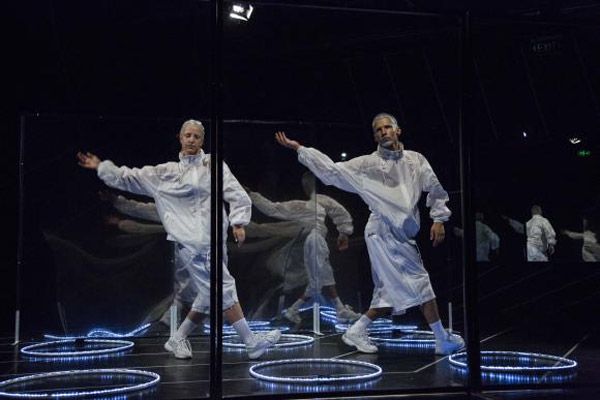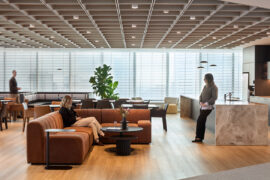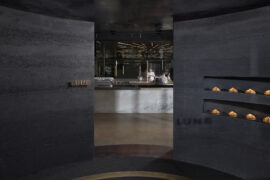Nicky Lobo + Sophia Watson explain how the design industry can take a que from the dance world, as with recent Dance House production, ‘Island’.

January 14th, 2015
Dance and architecture have long been linked through their shared use of space as a medium for creative interpretation. They are also closely linked through the way they both invite the audience to participate and immerse themselves within their environment.
This work entitled Island, brings the audience to the forefront of the stage – literally. Similar to the New York site-specific Sleep No More, the piece invites the audience to really take part in the performance.
With no designated seating, audience members are encouraged to walk amongst the futuristic constructs, lit by moving figures all in white and the illuminated floor highlighting the geometric nature of the design and the highly purposeful choreography of Batchelor.
By encouraging the audience to seek new perspectives, Batchelor’s choreography is given license to shift in size, orientation and reflection, allowing the surroundings to become a directing part of the movement, and the choreography to flow alongside the constructs.
This complex melting pot of influencers and inspirations is cooked-up by Batchelor Along with key collaborators, Architect and Designer, Ella Leoncio, Sound Designer Morgan Hickinbotham and fellow dancers Amber McCartney and Bicky Lee, to create an atmosphere that is distinctly eerie, engrossing and utterly hypnotic.
The main point we as designers and architects can take here is clear: Interactivity is king. Never has it been so important to promote opportunities for audiences – and more appropriately in our case, end users and general consumers – to participate within their surroundings and objects.
Look at any recent commercial project in the last five years, what is the common thread? Activity Based Working has exploded in the last few years, and why? because businesses are beginning to understand the impact working environments have on productivity.
As in the example of the Island dance performance, the success was largely predicated on the audience interacting with the space. The design industry could certainly stand to take a note or two.
INDESIGN is on instagram
Follow @indesignlive
A searchable and comprehensive guide for specifying leading products and their suppliers
Keep up to date with the latest and greatest from our industry BFF's!

From the spark of an idea on the page to the launch of new pieces in a showroom is a journey every aspiring industrial and furnishing designer imagines making.

Welcomed to the Australian design scene in 2024, Kokuyo is set to redefine collaboration, bringing its unique blend of colour and function to individuals and corporations, designed to be used Any Way!

London-based design duo Raw Edges have joined forces with Established & Sons and Tongue & Groove to introduce Wall to Wall – a hand-stained, “living collection” that transforms parquet flooring into a canvas of colour, pattern, and possibility.

Sustainability and meaningful experiences are key drivers in the hospitality sector today, as Bates Smart’s Brenton Smith shares with the studio’s latest regional hotel offering.

Anaca Studio has introduced a new line of furniture, designed specifically to enhance daily life in cosier, compact homes.

After 2016’s collaborative success with designer Sebastian Herkner, Caesarstone has been invited back by this year’s selected designer, New York-based Todd Bracher to help materialise his vision of the house of the future for Das Haus 2017- Imm Cologne.
The internet never sleeps! Here's the stuff you might have missed

GroupGSA delivers MUFG Pension & Market Service’s Sydney HQ with a dual Japanese–Australian identity, blending precision, warmth and workplace flexibility.

Cieran Murphy has been awarded The Photographer – Commercial at the INDE.Awards 2025. His work on Lune Rosebery captures the immersive design and storytelling of the space, highlighting the interplay of form, material and atmosphere in this contemporary culinary destination.